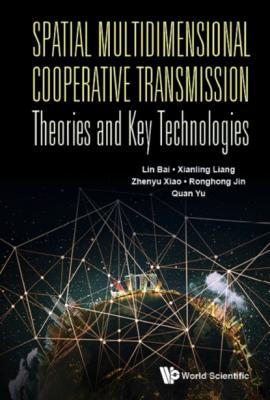Spatial Multidimensional Cooperative Transmission Theories And Key Technologies. Lin Bai
Читать онлайн.| Название | Spatial Multidimensional Cooperative Transmission Theories And Key Technologies |
|---|---|
| Автор произведения | Lin Bai |
| Жанр | Зарубежная компьютерная литература |
| Серия | |
| Издательство | Зарубежная компьютерная литература |
| Год выпуска | 0 |
| isbn | 9789811202476 |
The Alamouti algorithm of the 2 × 2 structure obtains the receive array gain (ga = MR = 2) but does not get the transmit array gain (because there is no channel information). The above method can get the full diversity
The diversity gain of both the Alamouti algorithm and the dominant eigenmode transmission is 4, but the array gain of the dominant eigenmode transmission is 3 dB larger than the Alamouti algorithm. Alamouti algorithm can also be used for any number of receive antennas
2.3.4.3MIMO system with partial transmit channel information
If the transmitter has only partial channel information, it is also possible to exploit the gain of the array. The complete channel information at the transmitter requires high-speed feedback links at both ends of the receiver and transmitter to ensure that the latter can continuously obtain channel state information. On the converse, exploiting the statistical property of the channel at the transmitter or the quantitative description of the channel requires only a lower rate feedback link.
Precoding techniques usually combine a multi-mode beamformer that can spread codewords in orthogonal directions of the channel distribution-related direction with a constellation shaper, or more simply, with a power allocation algorithm. There are many similarities with various eigenmode transmissions, while the difference is that the eigenbeam is based on the statistical property of matrix H rather than its instantaneous value.
Similarly, the antenna selection technique may also only depend on partial channel information, namely the first- and second-order statistics of the matrix H to select the transmitting or receiving antenna. Intuitively, they are selected from the antenna pair with the lowest selective correlation ratio. Such techniques do not minimize transient error performance metrics, but minimize the average error probability.
By quantization precoding, the generalization of antenna selection is to derive limited feedback from the transmitter. This technique depends on the selection of codebooks in the precoding matrix, which is a finite set of precoders. It can be designed offline and is known to both the transmitter and the receiver. The receiver estimates the best precoder as a function of the current channel and then feeds the index of the best precoder back into the codebook.
2.4MIMO Traditional Detection Technology
In Section 2.3.4, we introduced the basic concepts and principles of the MIMO systems. In the following, we will discuss the signal detection problem at the receiving end of the MIMO system from the perspective of the MIMO receiver.
2.4.1System model
The MIMO system model is shown in Fig. 2.11. Consider the system with two transmitting antennas and two receiving antennas as an example. Since each receiving antenna can receive signals from different transmitting antennas, the received signals from the two receiving antennas can be expressed as
where hij, sj, and ni represent the channel gain from the jth transmitting antenna to the ith receiving antenna, the transmitted signal of the jth transmitting antenna, and the additive noise of the ith receiving antenna, respectively. Defining y = [y1 y2]T, the received signal vector can be expressed by the matrix multiplication.
where channel matrix
Fig. 2.11. The MIMO system model.
2.4.2Uncoded MIMO signal detectionb
2.4.2.1Maximum likelihood MIMO signal detection
It can be seen from Eq. (2.145) that the purpose of detecting the MIMO signal is to estimate the unknown transmitted signal vector s when the received signal vector y and the channel matrix H are known. Although we are unable to obtain accurate information of the noise vector n, all possible cases of transmitting the signal vector s can be obtained in advance according to the modulation method. For an MIMO system with M transmitting antennas, if the transmitted symbols are taken from a constellation symbol set, then the number of all possible transmitted signal vectors is
In summary, maximum likelihood MIMO signal detection can be accomplished by retrieving all possible transmitted signals and calculating the corresponding likelihood function values. Defining f(y|s) as a likelihood function that transmits signal vector s when signal y is received, the transmitted signal vector of maximum likelihood can be expressed as
Since the maximum likelihood detection requires exhaustive retrieval and the number of all possible transmitted signal vectors is
2.4.2.2Linear MIMO signal detection
In order to reduce the complexity of detection, we can also consider using the linear filtering method to complete the detection process. In the linear MIMO signal detection, each transmitted signal can be detected separately after the received signal y is filtered by a linear filter. Therefore, the function of a linear filter is to separate the interference
